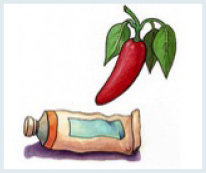Scientific name: 8-methyl-N-vanillyl-6-nonenamide
Brand names: Zostrix cream 0.025% or 0.075%, Salonpas Gel-Patch Hot, Sinus Buster (homeopathic intranasal spray).
The use of dietary supplements by patients with cancer has increased significantly over the past 20 years despite insufficient evidence of safety and effectiveness. Finding reliable sources of information about dietary supplements can be daunting. Patients typically rely on family, friends, and the Internet, often receiving misleading information.
The ASCO Post’s Integrative Oncology series is intended to facilitate the availability of evidence-based information on integrative and complementary therapies commonly used by patients with cancer. We chose capsaicin for this issue because of its increasing use as a pain reliever by cancer patients.
Overview
Capsaicin is a colorless, pungent ingredient found in cayenne pepper, a shrub that originated in Central and South Americas and is now cultivated in many tropical and subtropical climates. An important spice in many cuisines around the world, including Creole, Cajun, Mexican, Asian, and Southern Italian, cayenne pepper is valued in Ayurvedic and Chinese medical systems as a remedy for digestive and circulatory problems, poor appetite, and muscle and arthritic pain.
Today, topical capsaicin is used to treat pain associated with osteoarthritis, rheumatoid arthritis, mastectomy, postherpetic neuralgia, and diabetic neuropathy and to reduce the severity of psoriasis and pruritus.
Capsaicin has been studied in oral and topical forms. Current evidence suggests utility of topical capsaicin in controlling postoperative pain in cancer patients. However, data are limited to assess its effectiveness for arthritic pain and neuropathic pain associated with AIDS, diabetes, and mastectomy.
Capsaicin is marketed in capsule form and as an ingredient in topical creams, gels, and lotions. Prescription-strength dermal capsaicin products are available for the management of pain.
The Science
Capsaicin is believed to cause depolarization of C-fiber polymodal nociceptors, thereby releasing substance P, a neurotransmitter that relays pain signals to the brain. Following application of capsaicin, the sensation of pain increases due to release of substance P but subsides when its levels are depleted at the afferent neurons.1, 2
Topical capsaicin has been shown to be effective against psoriasis,3 prurigo nodularis,4 pruritus ani;5 a dermal capsaicin patch was found to be safe and effective for the treatment of postherpetic neuralgia.6 In another study, a combination of capsaicin and isoflavone improved hair growth in healthy volunteers with alopecia.7 Furthermore, capsaicin in intranasal form was shown to improve nasal congestion and sinus pain associated with nonallergic rhinitis.8
Data also indicate that capsaicin cream can control postoperative pain in cancer patients,9 but it was ineffective against distal symmetric peripheral neuropathy associated with AIDS.10 Capsaicin’s value in alleviating arthritic pain has not been fully established.11,12 A review of studies of capsaicin for neuropathic pain associated with HIV, diabetes, and mastectomy concluded that available data preclude full assessment of its benefits and that additional well-designed clinical trials are needed.13
Capsaicin, reported to have carcinogenic effects,14 was shown to be safe in a study of mice.15 Interestingly, studies following this observation found that capsaicin exerted chemopreventive properties.16,17 Proposed mechanisms of action include induction of apoptosis,18 inhibition of epidermal growth factor–induced invasion, and migration of tumor cells.19 A case report of a patient with prostate cancer showed that capsaicin may slow the doubling time of prostate-specific antigen (PSA).20
Adverse Effects
Increased arterial blood pressure and acute myocardial infarction were reported after ingestion of large amounts of chili peppers.21 Coronary vasospasm and acute myocardial infarction were observed following use of a topical capsaicin patch for 6 days. Improvement was seen after treating the symptoms and removal of the patch.22
Cases of serious burns have occurred after the use of over-the-counter topical products. In some cases, hospitalization was required.23
Herb-Drug Interactions
Antihypertensive medications: Capsaicin may affect the actions of antihypertensive medications.21 ■
Disclosure: Ms. Gubili reported no potential conflicts of interest.
Compiled by Barrie R. Cassileth, PhD, and Jyothi Gubili, MS, of Memorial Sloan Kettering Cancer Center. The free About Herbs website is managed by K. Simon Yeung, PharmD, MBA, LAc, of Memorial Sloan Kettering Cancer Center.
References
1. Lynn B: Capsaicin: Actions on nociceptive C-fibres and therapeutic potential. Pain 41:61-69, 1990.
2. Marsh SJ, Stansfeld CE, Brown DA, et al: The mechanism of action of capsaicin on sensory C-type neurons and their axons in vitro. Neuroscience 23:275-289, 1987.
3. Ellis CN, Berberian B, Sulica VI, et al: A double-blind evaluation of topical capsaicin in pruritic psoriasis. J Am Acad Dermatol 29:438-442, 1993.
4. Ständer S, Luger T, Metze D: Treatment of prurigo nodularis with topical capsaicin. J Am Acad Dermatol 44:471-478, 2001.
5. Lysy J, Sistiery-Ittah M, Israelit Y, et al: Topical capsaicin—a novel and effective treatment for idiopathic intractable pruritus ani: A randomised, placebo controlled, crossover study. Gut 52:1323-1326, 2003.
6. Backonja MM, Malan TP, Vanhove GF, et al; C102/106 Study Group: NGX-4010, a high-concentration capsaicin patch, for the treatment of postherpetic neuralgia: A randomized, double-blind, controlled study with an open-label extension. Pain Med 11:600-608, 2010.
7. Harada N, Okajima K, Arai M, et al: Administration of capsaicin and isoflavone promotes hair growth by increasing insulin-like growth factor-I production in mice and in humans with alopecia. Growth Horm IGF Res 17:408-415, 2007.
8. Bernstein JA, Davis BP, Picard JK, et al: A randomized, double-blind, parallel trial comparing capsaicin nasal spray with placebo in subjects with a significant component of nonallergic rhinitis. Ann Allergy Asthma Immunol 107:171-178, 2011.
9. Ellison N, Loprinzi CL, Kugler J, et al: Phase III placebo-controlled trial of capsaicin cream in the management of surgical neuropathic pain in cancer patients. J Clin Oncol 15:2974-2980, 1997.
10. Paice JA, Ferrans CE, Lashley FR, et al: Topical capsaicin in the management of HIV-associated peripheral neuropathy. J Pain Symptom Manage 19:45-52, 2000.
11. McCarthy GM, McCarthy DJ: Effect of topical capsaicin in the therapy of painful osteoarthritis of the hands. J Rheumatol 19:604-607, 1992.
12. Deal CL, Schnitzer TJ, Lipstein E, et al: Treatment of arthritis with topical capsaicin: A double-blind trial. Clin Ther 13:383-395, 1991.
13. Derry S, Lloyd R, Moore RA, McQuay HJ: Topical capsaicin for chronic neuropathic pain in adults. Cochrane Database Syst Rev (4):CD007393, 2009.
14. Toth B, Gannett P: Carcinogenicity of lifelong administration of capsaicin of hot pepper in mice. In Vivo 6:59-63, 1992.
15. Park KK, Chun KS, Yook JI, Surh YJ: Lack of tumor promoting activity of capsaicin, a principal pungent ingredient of red pepper, in mouse skin carcinogenesis. Anticancer Research 18:4201-4205, 1998.
16. Thoennissen NH, O’Kelly J, Lu D, et al: Capsaicin causes cell-cycle arrest and apoptosis in ER-positive and -negative breast cancer cells by modulating the EGFR/HER-2 pathway. Oncogene 29:285-296, 2010.
17. Yang ZH, Wang XH, Wang HP, et al: Capsaicin mediates cell death in bladder cancer T24 cells through reactive oxygen species production and mitochondrial depolarization. Urology 75:735-741, 2010.
18. Kim MY, Trudel LJ, Wogan GN: Apoptosis induced by capsaicin and resveratrol in colon carcinoma cells requires nitric oxide production and caspase activation. Anticancer Res 29:3733-3740, 2009.
19. Hwang YP, Yun HJ, Choi JH, et al: Suppression of EGF-induced tumor cell migration and matrix metalloproteinase-9 expression by capsaicin via the inhibition of EGFR-mediated FAK/Akt, PKC/Raf/ERK, p38 MAPK, and AP-1 signaling. Mol Nutr Food Res 55:594-605, 2011.
20. Jankovic B, Loblaw DA, Nam R: Capsaicin may slow PSA doubling time: Case report and literature review. Can Urol Assoc J 4:E9-E11, 2010.
21. Patanè S, Marte F, Di Bella G, et al: Capsaicin, arterial hypertensive crisis and acute myocardial infarction associated with high levels of thyroid stimulating hormone. Int J Cardiol 134:130-132, 2009.
22. Akçay AB, Ozcan T, Seyis S, Acele A: Coronary vasospasm and acute myocardial infarction induced by a topical capsaicin patch. Turk Kardiyol Dern Ars 37:497-500, 2009.
23. U.S. Food and Drug Administration: FDA Drug Safety Communication: Rare cases of serious burns with the use of over-the-counter topical muscle and joint pain relievers. Available at http://www.fda.gov/Drugs/DrugSafety/ucm318858.htm. 2012. Accessed February 5, 2015.
Guest Editor
Integrative Oncology is guest edited by Barrie R. Cassileth, MS, PhD, Chief of the Integrative Medicine Service and Laurance S. Rockefeller Chair in Integrative Medicine at Memorial Sloan Kettering Cancer Center, New York.
The Integrative Medicine Service at Memorial Sloan Kettering Cancer Center developed and maintains a free website—About Herbs (www.mskcc.org/aboutherbs)—that provides objective and unbiased information about herbs, vitamins, minerals, and other dietary supplements, and unproved anticancer treatments. Each of the close to 300 and growing number of entries offer health-care professional and patient versions, and entries are regularly updated with the latest research findings.
In addition, the About Herbs app, Memorial Sloan Kettering Cancer Center’s very first mobile application, can be downloaded at http://itunes.apple.com/us/app/about-herbs/id554267162?mt=8. The app is compatible with iPad, iPhone, and iPod Touch devices.




